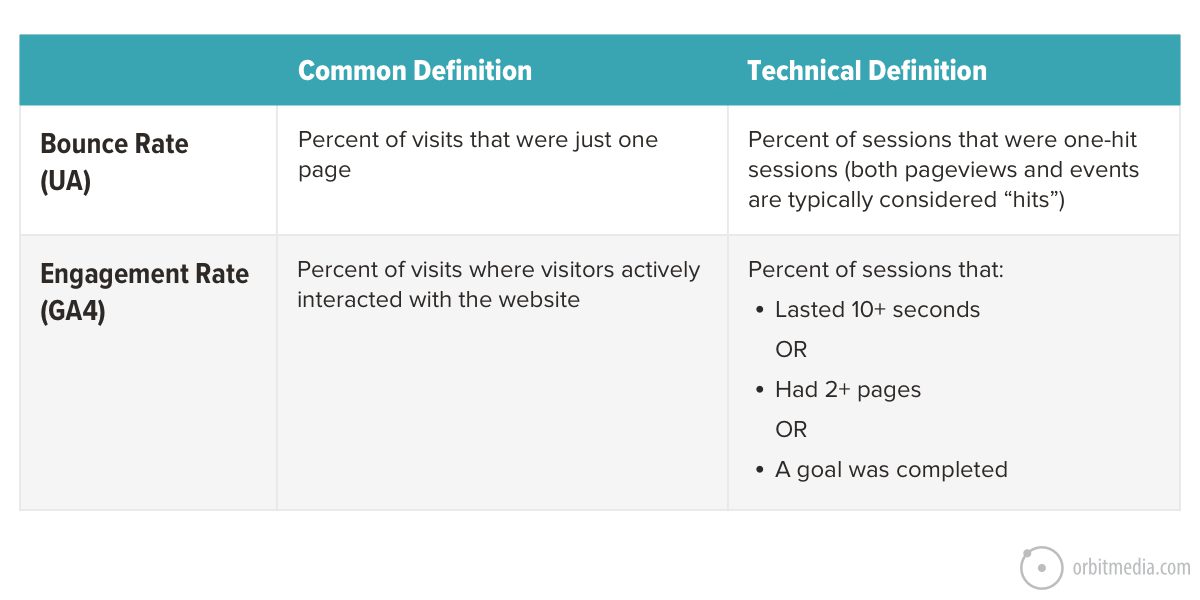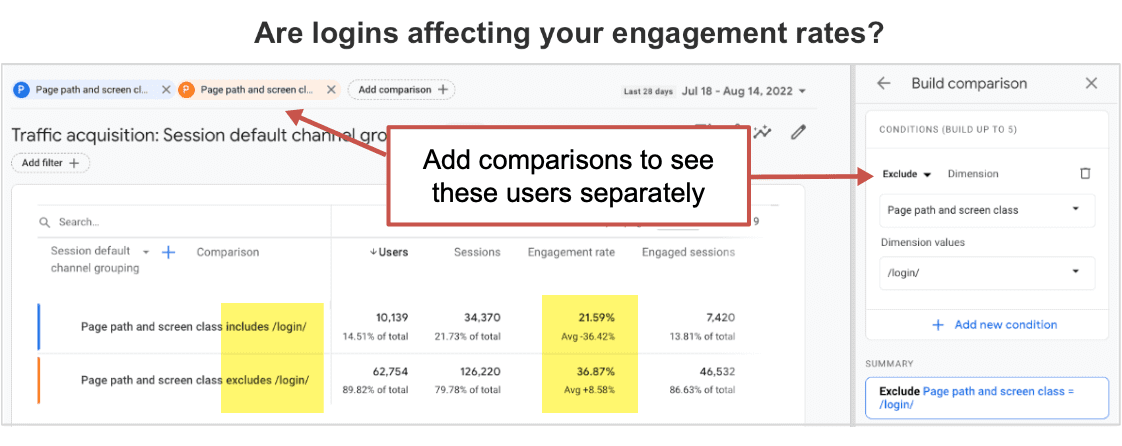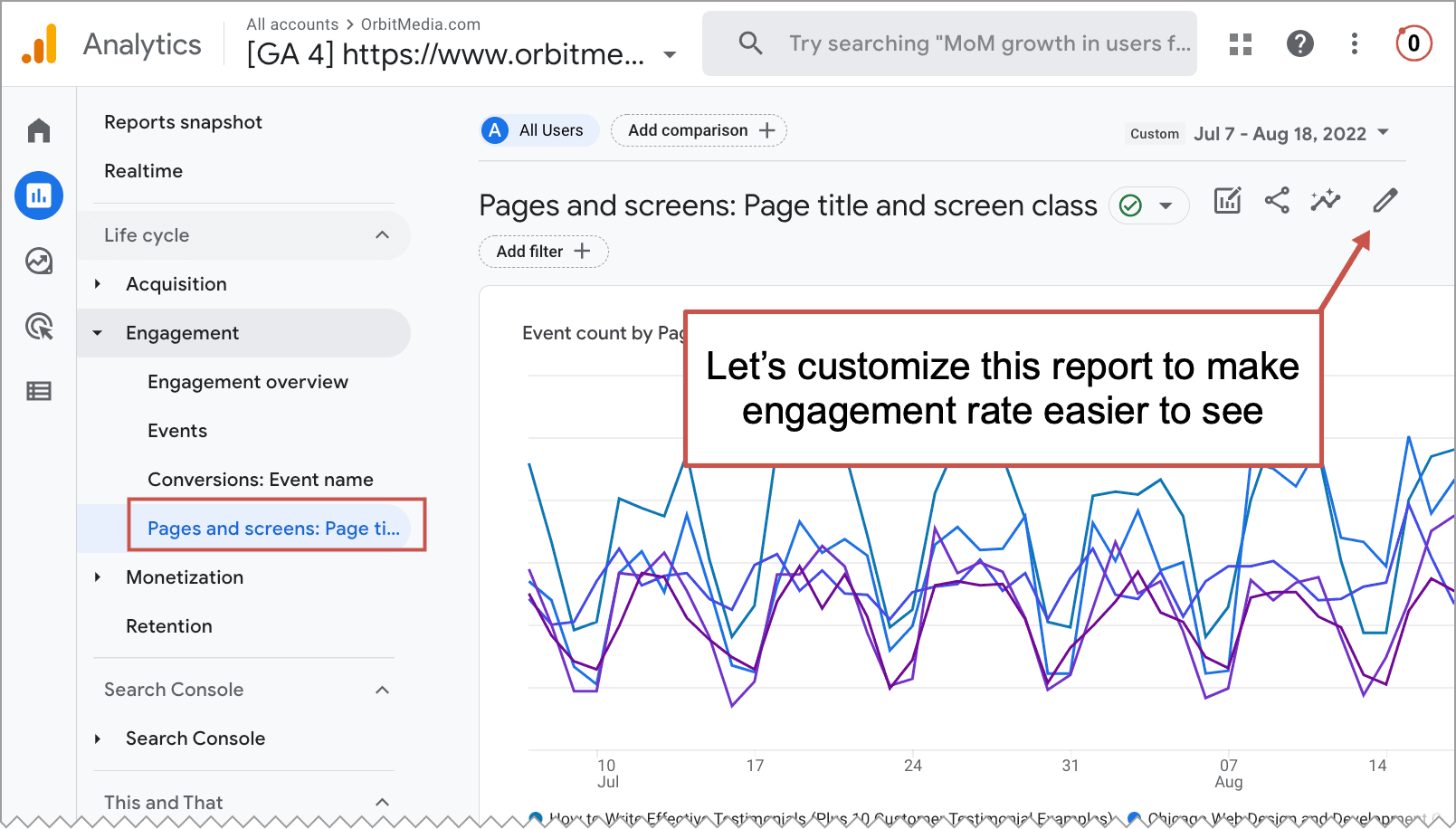Do your visitors like your page?
It’s a basic question. But not a simple question to answer using Google Analytics. The only way to measure visitor satisfaction is to use the metrics we have:
- We know if they didn’t click to see a second page (bounce)
- We have a good estimate for how long they stayed (average time on page)
- We know if they filled out a form (conversion)
For years, we used the first metric, bounce rate, as a proxy for visitor happiness. If they bounced, they must not have liked the page.
But that’s silly.
What if they stayed for 20 minutes and subscribed from your popup window? That’s great website engagement! But if it’s a one-page visit, it’s still a bounce.
But now, in Google Analytics 4 (GA4, the new version of Google Analytics) we have a new metric, engagement rate, which combines all three of the metrics listed above.
What is engagement rate in GA4?
The engagement rate is the percentage of sessions that were engaged sessions.
An “engaged session” is a website visit in which two or more pages were visited …OR the visitor spent more than 10 seconds on the website …OR they completed one of the goals. If any one of those three things happens, the visit is officially an engaged session.
How do you calculate engagement rate? You divide the number of engaged sessions by the number of total sessions. That’s it. But GA4 does this for you, giving the ratio, shown as a percentage.
The idea is to measure the percentage of visits where visitors actively interacted with the website.
What is the average engagement rate in GA4?
The idea here is to answer the “what is a good engagement rate?” question. Here are the preliminary results of a study we are conducting, after having installed GA4 on 65 client websites:
The average GA4 engagement rate is 55%
Average engagement rates vary by traffic source (default channel groupings) with organic sources generally having higher engagement than paid sources. This suggests that visitors from traditional SEO will be more engaged than visitors from Google Ads.

Compare this data to the findings of our average bounce rate study, which showed that across 500 websites, the average bounce rate is 62%.
Are there still bounce rates in GA4?
Yes.
But it doesn’t appear by default. You can add bounce rate as a metric to certain reports (such as Acquisition > Traffic acquisition and Engagement > Pages and screens) using a customization.
Also, the definition of bounce has changed. A bounce is no longer a one-page visit. Now in GA4, bounce rate is simply the inverse of engagement rate. In other words, in GA4, a bounce is a visit that did not include two pages, and the session duration did not last more than 10 seconds and did not involve a conversion.
Engagement Rate vs. Bounce Rate
Let’s compare the definition of bounce rate to GA4’s definition of engagement rate:

So you can see that engagement rate is a blend of several other metrics. Combined, they give you a better sense for the visitor’s behavior than bounce rate alone.
Compare the following examples of visits and you’ll see the difference. This chart shows how the same visit would look different according to the two metrics, bounce rate and engagement rate.

Is engagement rate a better metric than bounce rate?
Yes. Engagement rates are better than bounce rates, in my opinion. Analytics expert, Jeff Sauer, shares this view:
 |
Jeff Sauer Founder of Data Driven U“The idea of engagement rate in GA4 is almost too good to be true. Gone are the days of relying on bounce rate – the worst metric in the history of metrics (and not really a metric, but rather a lack of metrics) and replaced by something that sounds great: Engagement. But what exactly is engagement? What is time engaged with your site? Well, unlike bounce rate, it’s based on users taking action (not a lack of action like my high school days), by either viewing more than one page, converting, or having your tab open for at least 10 seconds (no comment from HS Jeff). So it’s better than bounce rate, but not perfect. Another thing to consider with engagement is that the time calculation requires your user to be actively viewing your site in their browser or app, not in the background. This leads to a calculation of engagement time that is 1/10th that of the time on site for Universal Analytics. In the end, GA4’s engagement metrics are far more accurate than they were in UA, but will also require a lot of getting used to if you’ve been reporting on TOS and bounce rate all these years.” |
We agree. Bounce rate was always a weird thing to track. It often shows false positives (high bounce rate but visitors were very engaged) or false negatives (low bounce rate but user experience was poor).
Just look at the bounce rates for your highest-traffic blog posts. They are likely very high. It’s no surprise. The visitors likely have a single question. Once they find the answer, they leave. Bounce! Even if they love the article and spend 5+ minutes engrossed in the topic.
Now look at the engagement rate for those same posts in GA4. The engagement rate may look great. The visitor is spending a lot of time on the piece, reading in detail, highly engaged.
Same URLs, same date range, different metrics. Which of these metrics is more useful?

Because it factors in time on the page, engagement rate is a better, more meaningful metric than bounce rate. It is similar to the social media engagement metrics that digital marketers are already familiar with.
We actually know Analytics experts who would always customize, creating an “adjusted bounce rate” which factors in time on page. With adjusted bounce rate, the visit would not be considered a bounce if they spent more than ten seconds on the page, even if they visited just one page.
In other words, some Analytics pros have been using engagement rate for years, but they’ve called it something else.
How to make engagement rates more accurate/meaningful?
Consider any issues that are artificially affecting your website engagement rates. It is the nature of some websites, some pages and some traffic sources to have “low engagement.”
For example, a banking website where users log in from the homepage.
These are current customers who are just on the site to log in. If you don’t want them affecting your engagement rates, just create a segment to exclude them. In the example below, I’ve created two segments, one to include and one to exclude users who touch the /login/ page.
Notice how they have very different engagement rates.

Similarly, you could use these GA4 comparisons just like you’d use UA segments, excluding things like blog post readers, career page visitors or obvious spam. This will sharpen your focus on the potential leads and marketing-focused pages.
You can also pull the data into Looker Studio and build a report with all kinds of engagement metrics, or do event tracking in Google Tag Manager, triggering conversion events that allow you to look at these visitors separately, but that isn’t necessary here.
How to increase engagement rates?
Do anything that increases time on page or triggers a click to a second page. These are the main inputs for the metric, so these are the ways to increase your engagement rate.
Here is a list of 15 ways to increase engagement rates for any website, specific web page or even mobile app. The idea behind the recommendations is to use basic digital marketing strategies. These are all common recommendations from any engagement rate analysis.
Tactics that will reduce back button clicks (bounces/one-page visits):
The visitor will judge the relevance and beauty of the page in less than one second.
1. Make sure the H1 header is specific and descriptive
2. Remove clutter and visual noise (add whitespace)
3. If it’s a blog with evergreen content, remove dates from the template (you can still include them in the content)
Tactics that will increase time on page:
The more cluttered, crowded or confusing the page, the lower the time on page will be, and therefore, the lower the engagement rate will be.
4. Add depth and detail to the content
5. Use short paragraphs, especially high on the page
6. Add a video to the top of the page
7. Add a chart or graph at the top of the page
8. Add an image at every scroll depth
9. Add quotes and faces from contributors
Tactics that will increase clickthrough rates to subsequent pages:
Any click to any other page makes it an engaged visit. So make those links and buttons work harder.
10. Add internal links to related resources, specifically linking to articles with high CTR headlines
11. Make the link text specific (change “read more” to “see how we increased engagement by 24%”)
12. Add calls to action (just having one “contact us” button at the top is insufficient)
More digital marketing tactics for increasing engagement rates:
Aside from the page itself, you can increase the overall website engagement rate by changing the traffic mix or website architecture.
13. Increase traffic from high-engagement sources (check your Traffic Acquisition reports and consider your ad spend, social media strategy, etc.)
14. Remove super-low engagement URLs. This is drastic but effective.
15. If a common interaction looks like a one-page visit to Google Analytics, such as visitors click the login button (banking websites) or tell us their age (alcohol websites), then adjust the site so those clicks are tracked as pageview interactions.
Should I switch to GA4 for this?
It’s time to start getting familiar with the new version of Analytics, and engagement rate is a nice excuse to log in and look around.
Here is a very simple step-by-step starting point for customizing a very basic report to make engagement rates more visible.
- Log into your Analytics, select your GA4 property (notice, there are no views in GA4)
- In the “Reports” section, click on Engagement > Pages and Screens
- Click on the pencil icon in the top right (customize)

- In the Customize Report panel on the right side, you’ll see “Dimensions” and “Metrics” at the top. Click on the arrow next to Metrics.
- Now you can change the order of the columns of metrics for this report. Let’s slide Engagement Rate up.

- Click save.
This is what the customized report will look like:

You just customized a report in GA4. You also know what engagement rate is, how it is calculated and how to improve it for your website. It’s been a good day for your Analytics skills.
You are one step closer toward true proficiency in Google Analytics 4. Bravo! 👍




